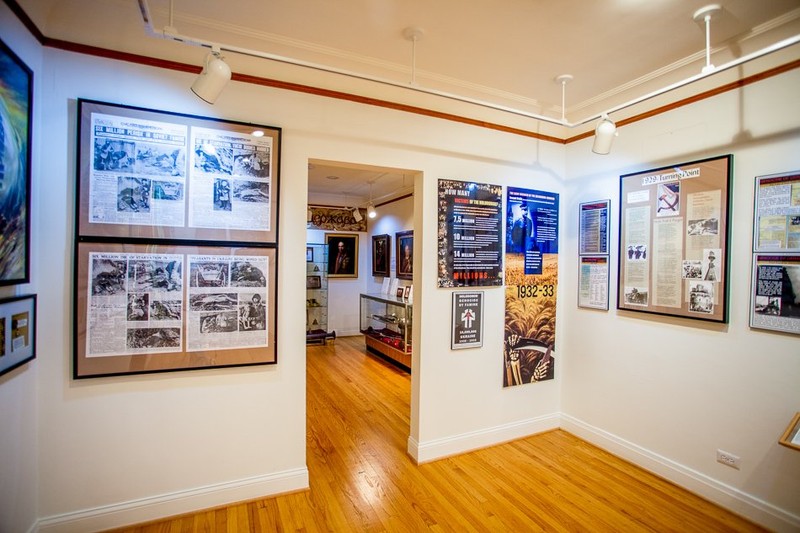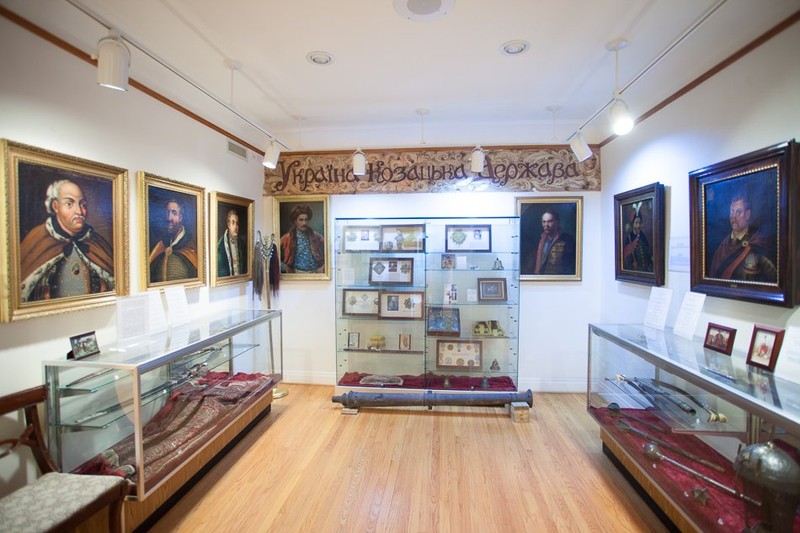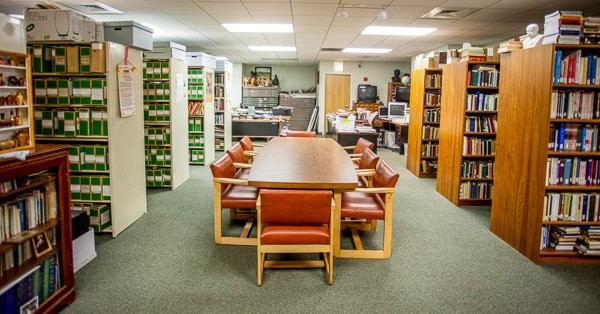Ukrainian National Museum
Introduction
Text-to-speech Audio
This Chicago museum was founded in 1952 by Ukrainian scholars fleeing the Soviet Union and offers exhibits and programs that help share Ukrainian history along with the experience and perspectives of Americans of Ukrainian heritage. The museum is located in Chicago's historic Ukrainian Village neighborhood, a longtime center of the Ukrainian American community. The museum contains thousands of artifacts from folk art to war memorabilia and a library and archives. The museum also hosts many programs around the year including art exhibits, cultural activities, and community events.
Images
The Ukrainian National Musuem was founded in 1952 in Chicago's historic Ukrainian Village neighborhood. Image obtained from the Ukrainian National Musuem.

The museum hosts many permanent and temporary exhibits. This one is dedicated to Holodomor, a famine-genocide that killed up to 10 million people during Soviet rule in 1932-1933. Image obtained from the Ukrainian National Museum.

The Kozak Period exhibit features a variety of weapons and portraits of the Kozak Hetmans. Image obtained from the Ukrainian National Museum.

The museum also has a library containing thousands of books on Ukraine, Ukrainian immigration to America, and Ukrainian American organizations. It is open to the public by appointent only. Image obtained from the Ukrainian National Museum.

Backstory and Context
Text-to-speech Audio
Ukrainian migration to the United States started in the second half of the nineteenth century and came in a series of waves. The first major immigration wave lasted from 1870 to 1899. These immigrants consisted mainly of poor farmworkers seeking better economic opportunities. Many of them settled in the rural areas of Texas, North Dakota, New Jersey, New York, Virginia, West Virginia, and Pennsylvania; often they took up farming or worked in coal mines. The second wave lasted from 1900 to the beginning of World War I in 1914. These immigrants sought factory jobs and moved to industrial cities such as Boston, Cleveland, Detroit, Baltimore, New York City, Philadelphia, and Chicago. The third wave was from 1920 to 1939; these were political immigrants, driven by the chaos caused by Ukraine’s declaration of independence in 1918, and its forced absorption into the Soviet Union four years later. Soviet dominance of Ukraine following World War II spurred another wave from 1948 to 1955, this time consisting of many intellectuals, artists, and political dissidents. The last major wave of immigration came in the 1990s when the Soviet Union collapsed and Ukraine regained its independence. Today it is believed that between one and two million Americans are of Ukrainian descent.
Chicago is home to the most prominent Ukrainian American community in the United States, in the historic Ukrainian Village neighborhood. Located around the 2300 and 2400 blocks of Chicago Avenue in the West Town area, the neighborhood acquired its identity when Ukrainian immigrants began to outnumber other groups in the early 1900s. Several historic Ukrainian churches, including the St. Nicholas Greek Catholic Church, formed the centerpiece of the Ukrainian Village. Ukrainians from every major immigration wave have lived in the neighborhood; it contains a plethora of Ukrainian-owned businesses and cultural institutions. Several portions of the Ukrainian Village have been designated a Chicago Landmark District.
The Ukrainian National Museum was established in 1952 by scholars Olexa Hankewych, Julian Kamenetcky, and Orest Horodysky, with financial support from activist Dr. Myroslav Simynovycz. They had come to the United States during the post-World War II immigration wave; their original goal for the museum was to collect and preserve materials that would then be brought back to Ukraine when it became independent again. It has since evolved and now works to preserve Ukrainian culture and educate the public about the history and contributions of Ukrainian Americans. The museum contains thousands of artifacts including large collections of folk art and fine art; religious objects from Archbishop Andrey Sheptytsky; items brought by immigrants; and Ukrainian American veteran memorabilia. In addition to hosting events and temporary exhibits on Ukrainian art and history, the museum has several permanent exhibits including ones dedicated to Pysanky (traditional decorated Easter eggs); the Ukrainian pavilion at the 1933 Chicago World’s Fair; the 1932-1933 Holodomor genocide; and Ukrainian American veterans. The museum also has a library and archives (open by appointment only) containing thousands of books and documents on Ukraine, Ukrainian immigration, and Ukrainian American organizations.
Sources
Ferguson, Jamie Lynn. “Ukrainian Village: Traditions overcome ‘hottest neighborhood’ label.” Chicagoly. March 22, 2017. Accessed February 12, 2018. https://chicagolymag.com/web/2017/03/ukrainian-village-traditions-overcome-hottest-neighborhood-label/
Hrushetsky-Schiffmn, Oryna. “Four waves of Ukrainian immigration celebrate Ukrainian National Museum’s 65th anniversary.” The Ukrainian Weekly. December 22, 2017. Accessed February 12, 2018. https://www.ukrweekly.com/uwwp/four-waves-of-ukrainian-immigration-celebrate-ukrainian-national-museums-65th-anniversary/
Hrycak, Alexandra. “Ukrainians.” Encyclopedia of Chicago. Accessed February 13, 2018. http://www.encyclopedia.chicagohistory.org/pages/1279.html
Klimchak, Yaryna. “Ukrainian National Museum in Chicago begins 60th year.” The Ukrainian Weekly. November 20, 2011. Accessed February 13, 2018. http://ukrweekly.com/archive/2011/The_Ukrainian_Weekly_2011-47.pdf
Miziuk, George A. “Ukrainians in the U.S.” Embassy of Ukraine In The United States Of America. Accessed February 12, 2018. http://usa.mfa.gov.ua/en/ukraine-us/ukrainians-in-us
Rogers, Monica Kass. “Old World meets modern vision in West Town’s Ukrainian Village.” Chicago Tribune. February 20, 2009. Accessed February 12, 2018. https://www.chicagotribune.com/chi-ukrainian_village_chomes_022feb20-story.html
Image 1: http://ukrainiannationalmuseum.org/wp-content/uploads/2015/02/Facade-0349-21.jpg
Image 2: http://ukrainiannationalmuseum.org/wp-content/uploads/2015/04/UNMProkopivV5-0187.jpg
Image 3: http://ukrainiannationalmuseum.org/wp-content/uploads/2015/04/UNMProkopivV5-0196.jpg
Image 4: http://ukrainiannationalmuseum.org/wp-content/uploads/2015/04/UNMProkopiv-31-of-38.jpg
